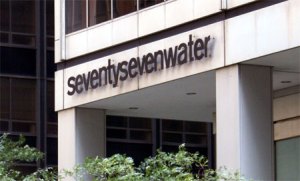
Building tops in downtown Manhattan offer little in the way of eye-catching spectacle—imagine, for a minute, that you’re staring down, not up, at one of those gargantuan fortresses of steel—and 77 Water Street is not a structure that readily distinguishes itself from its Financial District cohorts. It’s an oversize air-conditioner of a building, vents running like industrial gills up its sides, roughly the color of an old computer monitor.
But if you could manage a glimpse from above, you’d see its airplane.
For the past four decades, a World War I Sopwith Camel fighter has sat idling on a long green runway atop the building’s roof. A source of amused curiosity for the denizens of overlooking skyscrapers (as well as some initial trouble with the Federal Aviation Administration), the life-size model airplane has otherwise maintained something of a nonexistent existence. Not open to the public, invisible from the street below, it sits at the edge of its runway eternally poised for flight.
In March of 2008, Goldman Sachs put 77 Water Street on the market. It had leased the entire nearly 600,000-square-foot building in 2000-one of several ancillary office buildings it rented in the neighborhood of its Broad Street headquarters. That was at the height of the 1990s dot-com boom, when projections indicated the firm’s workforce could expand to as many as 30,000 employees within a decade. It was also the year that the boom went bust, and Goldman never moved in.
Now after close to a decade, as the firm relocates its headquarters to the new 200 West Street, Goldman is finally closing several major deals in the building it never actually occupied. AT&T will take the largest plot at 100,000 square feet, followed by law firm Lewis Brisbois Bisgaard & Smith, UnitedHealthcare and OneBeacon Insurance Group. The rents were around $35 a square foot, according to Crain’s, with generous building allowances.
For a firm that trades largely in invisible things, especially if that firm holds secrecy as a governing covenant, real estate can sometimes offer a singularly corporeal history: gambles and doubling-backs, an artful dodge of a broader economic trajectory here, a negotiation of a political one there, all spelled out in concrete and stone. Between a roughly $40 billion government bailout, payout on its AIG debt, prodigious bonuses and the recent revelation that Goldman bet heavily against the very mortgage-related securities it peddled, it’s not surprising that an empty building in the Financial District has received little scrutiny. But the history of Goldman at 77 Water Street—a non-history, really, since it was never actually there—is an odd glimpse into the famously guarded company.
In the 1960s, Melvyn Kaufman, the developer of 77 Water Street, acquired a reputation as something of a maverick, an iconoclast—a rogue developer, if you will. It’s a reputation he earned not so much for his buildings themselves—numbingly banal boxes engorged to block-swallowing hulk—but for his attitude toward them. “Every building is an obscenity,” he once said. “I think every building carries with it an obligation that from the moment you begin to the day you die, you must apologize.”
It’s difficult to imagine many developers today apologizing for their buildings, even when the obscenities of those buildings are markedly apparent to the rest of us. But Mr. Kaufman did more than apologize. He constructed physical incarnations of his apologies from metal and stone. He commissioned art objects and whimsical public spaces in and around his obscenities, as if to cushion the blow. The result was a curious dynamic: mini-carnivals encased in glass-and-travertine tombs. On Third Avenue, Mr. Kaufman installed a giant game of chess. At 127 John Street, he commissioned Rudolph de Harak to create a neon-lit, corrugated-metal tunnel for an entranceway and a three-story digital clock. The American Institute of Architecture called it “a no-nonsense building with a happy nonsense-filled lobby and sidewalk.”
At 26 stories, the bland and economical 77 Water Street was completed in 1970 with Mr. Kaufman and his brother Robert at the helm. The plans were drawn up by the architects at Emery Roth & Sons, a firm better known for its ability to maximize net rentable area than for its commitment to aesthetics. But this building, too, had its swaths of happy nonsense. A series of ponds meandered through the public plaza, traversed by small footbridges and filled with streambed rocks and jumping metal fish. Heat lamps were shaped like trees and seats like mushrooms. Hyper-modern sculptures were installed here and there, and in an unlikely final touch, an old-fashioned candy store was thrown in, too.



